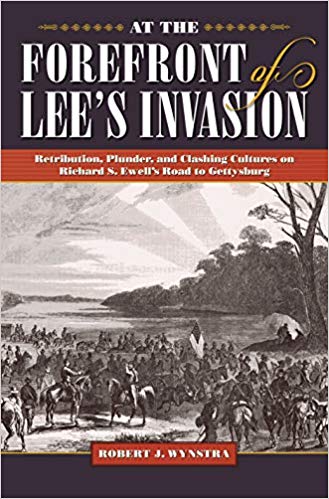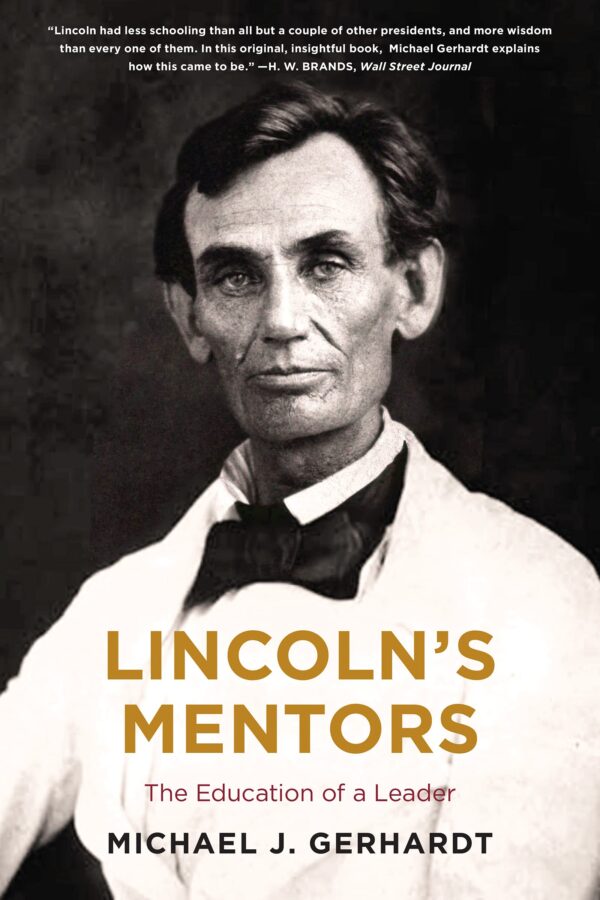At The Forefront of Lee’s Invasion: Retribution, Plunder, and Clashing Cultures on Richard S. Ewell’s Road to Gettysburg by Robert J. Wynstra. Kent State University Press, 2018. Cloth, IBSN: 978-1606353547. $49.95.
 At the moment of Gettysburg’s sesquicentennial, it was estimated that nearly half of the approximately 65,000 books published about the Civil War in some way focused on the war’s bloodiest battle. Because such a vast literature already exists about the Gettysburg Campaign, one might easily surmise that it would be impossible for anyone to produce anything original about it. Robert J. Wynstra successfully challenges that assumption with his recent volume, one destined to become a staple for anyone seeking a deeper, more nuanced understanding of the campaign’s opening weeks.
At the moment of Gettysburg’s sesquicentennial, it was estimated that nearly half of the approximately 65,000 books published about the Civil War in some way focused on the war’s bloodiest battle. Because such a vast literature already exists about the Gettysburg Campaign, one might easily surmise that it would be impossible for anyone to produce anything original about it. Robert J. Wynstra successfully challenges that assumption with his recent volume, one destined to become a staple for anyone seeking a deeper, more nuanced understanding of the campaign’s opening weeks.
Wynstra, perhaps best-known for his multiple prize-winning The Rashness of that Hour, has produced an exhaustively researched, extremely detailed, and skillfully crafted narrative chronicling the march of Confederate General Richard S. Ewell’s corps into Pennsylvania. Throughout the book’s sixteen chapters, Wynstra ably follows Ewell’s three divisions (under the command of General Robert Rodes, General Edward Johnson, and General Jubal Early) into the Keystone State. His book, however, does more than merely chronicle Ewell’s advance into the Shenandoah Valley, the corps’ march into Pennsylvania, and the engagements at Winchester, Berryville, and Martinsburg.
Indeed, much of this book’s value rests in Wynstra’s keen analysis of how civilians in the various communities through which Ewell’s regiments passed coped with Confederate occupation. In every community north of the Mason Dixon, civilians braced themselves for the worst. As news spread of Ewell’s advancing columns, many civilians reacted in a typical manner—hiding valuables, foodstuffs, and livestock. Beyond commonplace reactions to news of approaching Confederates, Wynstra shows that some Pennsylvania civilians did whatever they could in order to minimize the possibility of Confederate reprisals. For example, in Shippensburg, Pennsylvania, the owner of the Union House hotel so tremendously feared that the name of his establishment would excite Confederate general Albert Jenkins’s troopers that he painted over it. Throughout other parts of southern Pennsylvania, civilians informed Confederates that they supported Peace Democrats or were Copperheads in order to avoid having property stolen or destroyed.
While many civilians agonized about Confederate soldiers ransacking their property, Wynstra’s diligent research reveals that some civilians, albeit not widespread, boldly confronted Confederate soldiers. For instance, when Confederate cavalry entered Chambersburg, Pennsylvania, a small contingent of the town’s civilians—led by a resident brandishing a piece of plastering lath as a sword—approached two Confederate troopers and disarmed them. At the spectrum’s opposite end, Wynstra highlights the fate of Isaac Strite, a farmer in Marion, Pennsylvania. When Strite confronted three Confederates from Jenkins’s command and informed them they could take what they wanted, so long as they spared his barn, they murdered Strite and buried him in a pile of dung (96).
In addition to examining attacks on civilians, foraging, and plundering by Confederates, Wynstra also highlights the efforts of Confederates—as well as Virginia slave owners who followed Ewell’s corps into Pennsylvania—to capture runaway slaves. As determined as Confederates and slave owners might have been to seize runaways, Wynstra convincingly shows that some white inhabitants of the Keystone State were equally determined to prevent African Americans from being returned to slavery. Some spirited slaves north toward Harrisburg, while others concealed runaways. Unless moved from the Confederates’ path, Wynstra lucidly argues throughout that no Africans Americans, either those born as slaves who sought refuge in southern Pennsylvania or those born free, enjoyed any security during Ewell’s advance.
Careful to point out that some Confederates pitied civilians or practiced restraint, Wynstra admirably posits some ways in which Confederate soldiers justified their boorish behavior. Some lashed out and did as they pleased. This was especially true of the Georgia soldiers in Ewell’s command, who believed their actions just retribution for the recent burning in Darien, Georgia. Furthermore, Wynstra maintains that some Confederates pillaged because they believed that bringing war to the North’s civilians might result in a speedier end to the conflict.
While some of Ewell’s troops viewed their actions in southern Pennsylvania as an opportunity to avenge destruction, fill their stomachs, or convince President Abraham Lincoln to capitulate, the author notes that others viewed that verdant countryside as something that would eventually contribute to Confederate defeat. With a weakening economy and dwindling resources some, such as the 57thNorth Carolina’s Marcus Hefner, believed the Confederacy could never overcome the Union’s bounty and win the war. That march north then became, as Wynstra writes, a wake-up call for some Confederates who “knew that the North’s wealth would prove decisive in the long run” (165).
There is little to criticize about Wynstra’s exhaustively researched, skillfully written, and nuanced history. While this book is certainly a necessity for students of the Gettysburg Campaign, those who seek a deeper understanding of the interactions between Confederate soldiers and white civilians, Confederates and African Americans, or how soldiers justified bringing war to people’s doorsteps will find Wynstra’s volume inestimably valuable.
Jonathan A. Noyalas is director of Shenandoah University’s McCormick Civil War Institute, founding editor of Journal of the Shenandoah Valley During the Civil War Era, and the author or editor of eleven books on Civil War era history.
